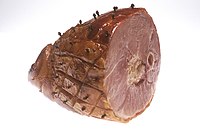
Photo from wikipedia
This study investigates the purification and biochemical characteristics of the protease secreted by Lactobacillus curvatus R5, which was isolated from Harbin dry sausages. The optimized fermentation conditions were fermentation time… Click to show full abstract
This study investigates the purification and biochemical characteristics of the protease secreted by Lactobacillus curvatus R5, which was isolated from Harbin dry sausages. The optimized fermentation conditions were fermentation time 36 h, initial pH 6 and fermentation temperature 37 °C. An extracellular protease was purified using ammonium sulfate precipitation, ion-exchange layer and gel filtration. Sodium dodecyl sulphate-polyacrylamide gel electrophoresis (SDS-PAGE) analysis showed that molecular weight of the purified protease was 45.3 kDa. Protease produced by L. curvatus R5 reached a higher relative protease activity at pH 6, 40 °C, and the purified protease exhibited pH and thermal stability at pH 6 and 40 °C. The microbial protease activity can be inhibited by ethylene diamine tetraacetic acid disodium salt (EDTA). The Vmax and Km of the protease were 53 mg/min and 15.9 mg/mL, respectively. SDS-PAGE reflects the ability of the protease to hydrolyse myofibrillar protein and sarcoplasmic protein, especially on myosin heavy chain, actin, myosin light chain and phosphorylase. The 3D structure and the Ramachandran plot of L. curvatus R5 protease was obtained by homology modelling. The Ramachandran plot analysis revealed that the purified protease was composed of 366 amino acids, and its residues in favoured, allowed, generously allowed and disallowed regions were 84.6%, 11.3%, 3.2% and 0.9% residues, respectively. Molecular docking showed that the substrate actin bound to the protease active site by hydrogen bonding and hydrophobic interaction. This research provides a basis for understanding the enzymatic properties of L. curvatus R5 protease. In conclusion, L. curvatus R5 can be used as a starter culture or protease-producing strain to inoculate Harbin dry sausages.
Journal Title: International journal of biological macromolecules
Year Published: 2019
Link to full text (if available)
Share on Social Media: Sign Up to like & get
recommendations!